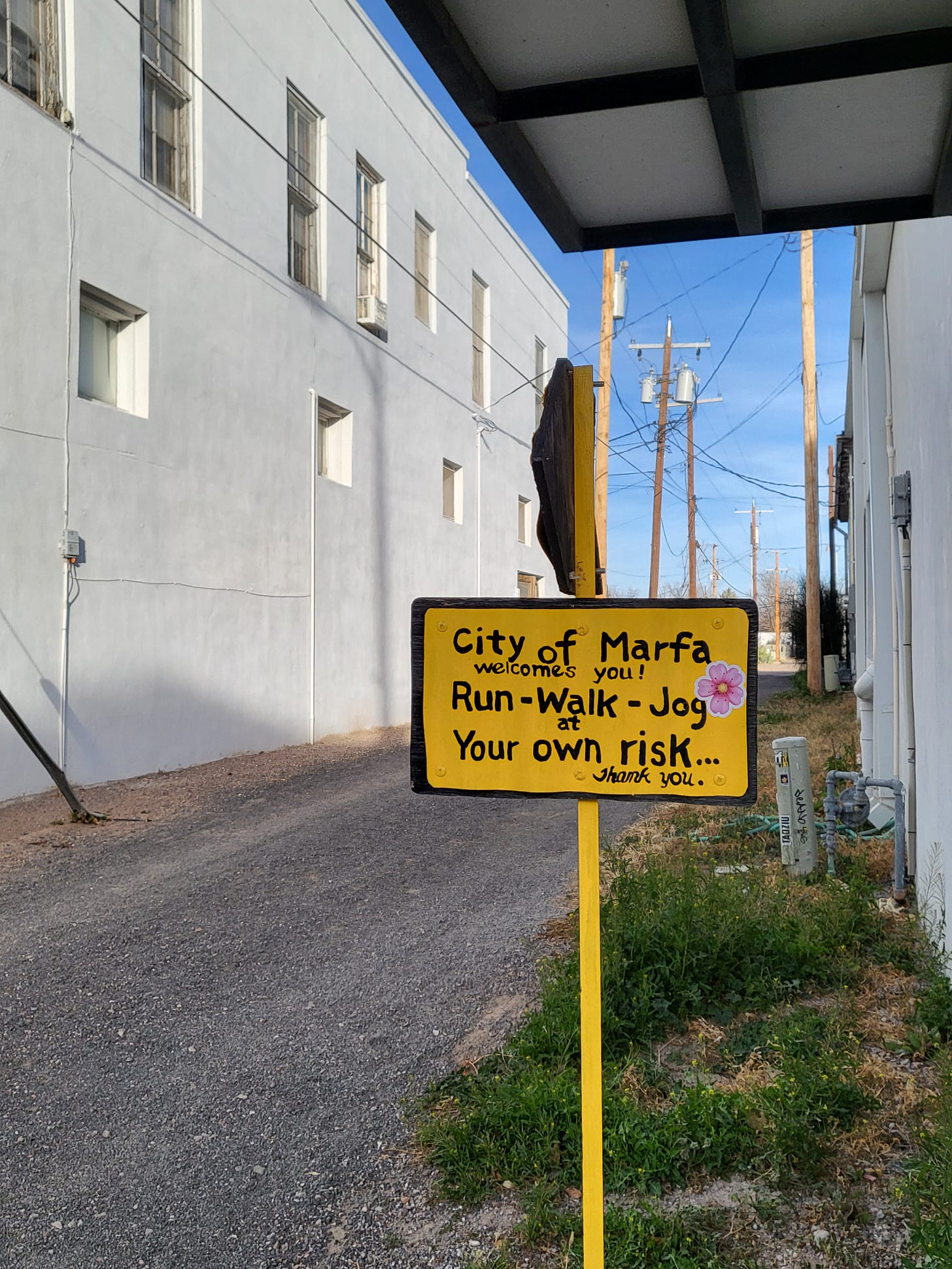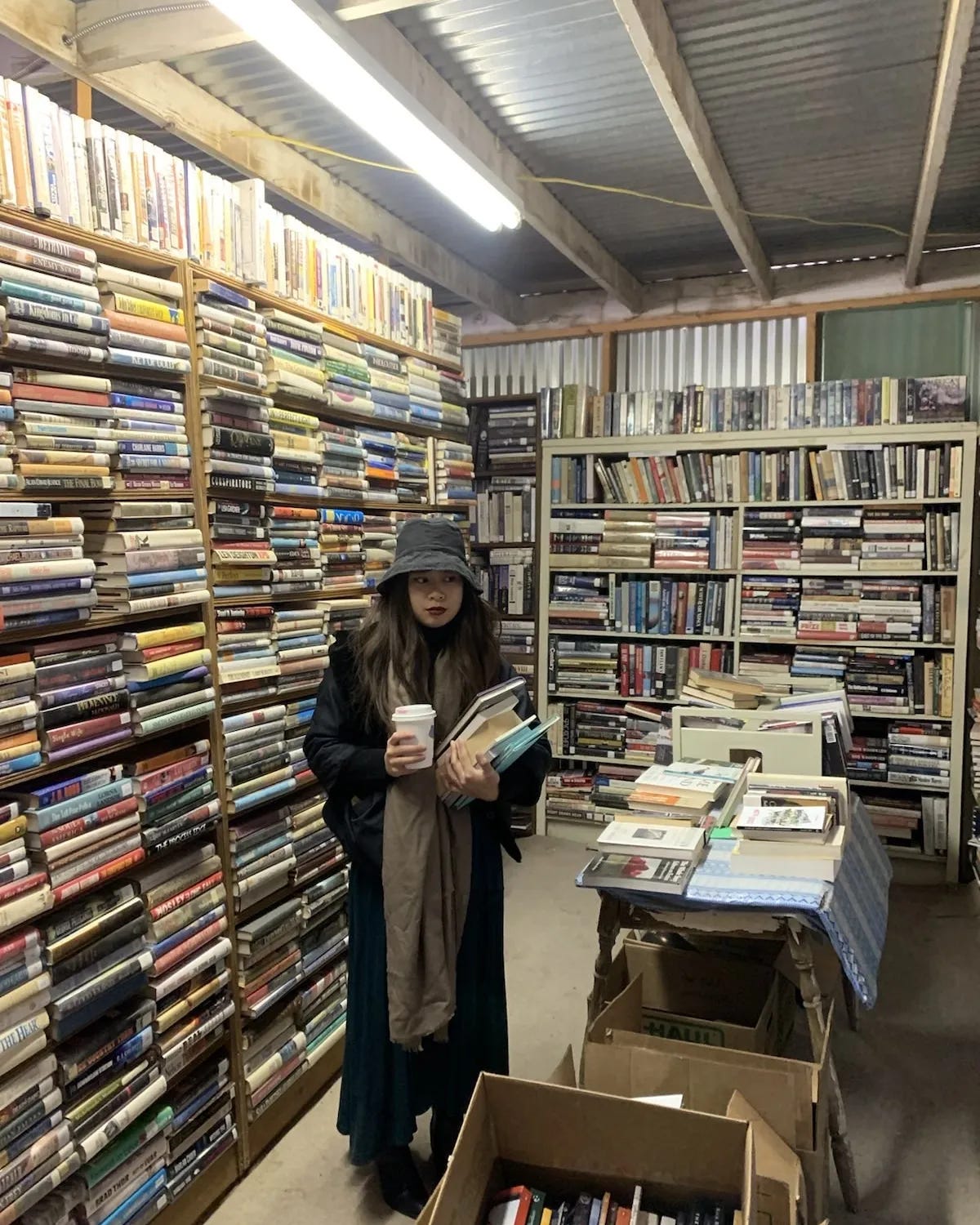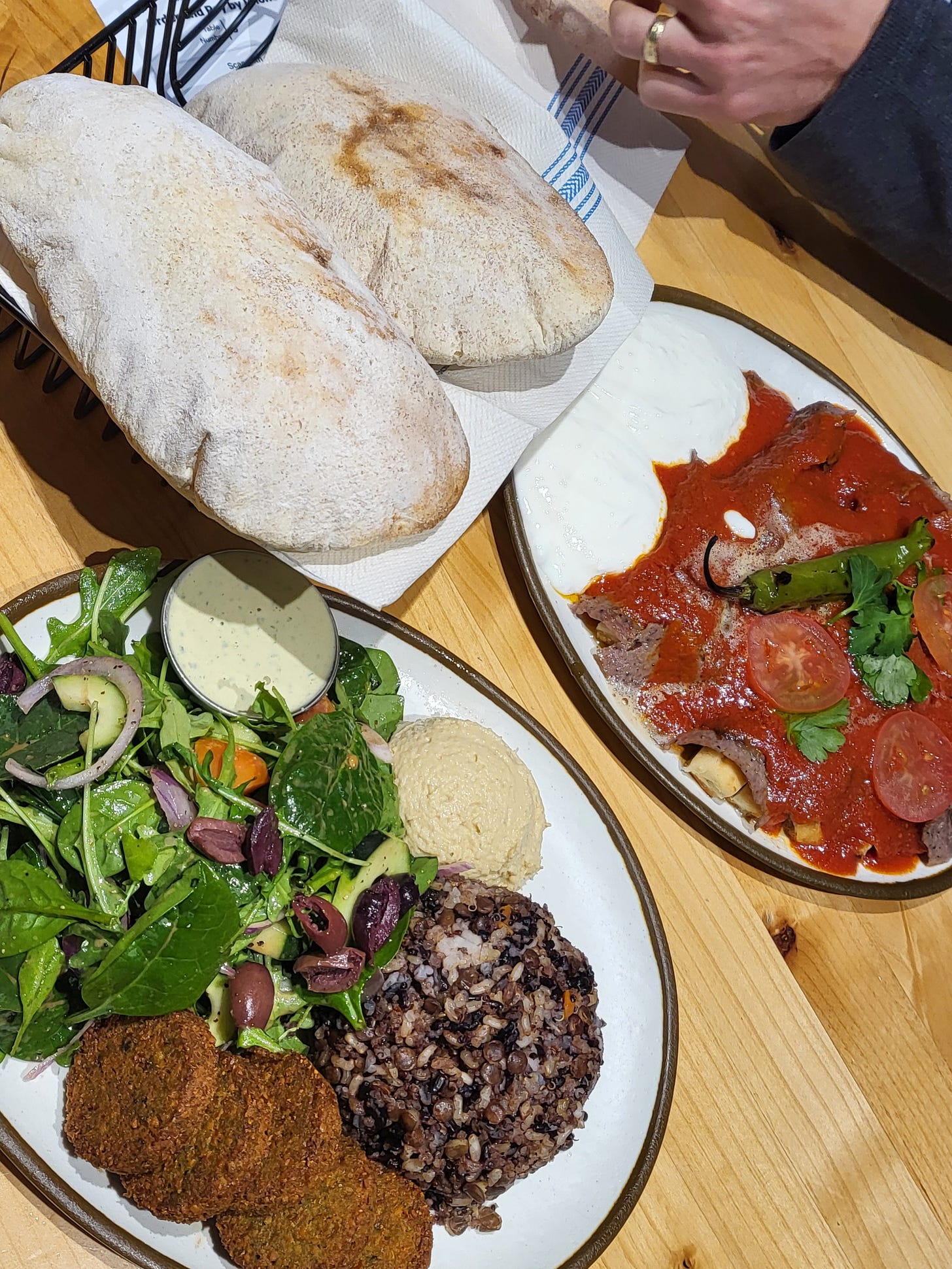A year in vignettes: part two
Memorable encounters during my trip to Marfa, Texas, and reflections on my picky tastebuds
Read Part One here.
IV.
This town doesn’t actually exist, Michael and I joked repeatedly during the two-hour drive from the border town of Presidio to Marfa. For miles, desert extended infinitely in all directions, and even when Google Maps said we were ten minutes away from town, the road ahead gave no hint of an approaching settlement.
We finally arrived past four in the afternoon at our rental along E Lincoln. The small house that was to be our temporary home for the next three days belonged to a Marfa native who worked at the Marfa Public Radio, the office of which was only three blocks away. We never met our host, but even from our brief exchanges online and our stay at his tastefully designed house, he seemed like a genuinely welcoming local.
It was refreshing to be in a walkable town in Texas. Most places in the state are hostile to pedestrians, whether through a lack of shade or sidewalks, or through distances too far to reasonably walk. Marfa, meanwhile, was a small enough town that everything was within walking distance, so Michael and I seized the opportunity to explore it on foot despite the biting cold we were not used to. Only through walking—our hands in leather gloves, our shoulders raised to our ears—did I see the stickers on lampposts, the graffiti on the dumpster behind the modern store-cum-gallery, the desert flora that persists in empty alleys and cracks in the cement. For breakfast one morning we brisk walked to Do Your Thing, a craft coffee shop highly recommended by a local storekeeper we spoke with on the day of our arrival. I ordered a Mayan Mocha, the storekeeper’s favorite, while Michael tried the Nero Latte, which was sweetened with date syrup and colored with activated charcoal. Our shared meal, the Everything Toast, was composed of cream cheese, tomato, greens, and one of the best slices of sourdough I have ever tasted.
At the public bulletin board outside The Get Go grocery on Dean Street I saw an announcement for a small get-together at the public library happening the next day. The prospect of books, free donuts, and coffee made the library visit a priority on our agenda. We headed there as soon as the library opened at 10 o’clock, the sky bright and cloudless. By the door was a cart of used books for sale, which I perused for a good fifteen minutes before entering the building.
Inside was warm and alive. The crowd that morning was composed primarily of kids playing or reading around what seemed to be a robust children’s section. I walked deeper into the building, which I thought was quite large given the size of the town, and gravitated towards the thin but prominent Local Picks shelf. (I walked past the table with the free powdered donuts out of shyness.) I thumbed through a couple of titles, many of which were historical, and found an interesting book called And Those Ashen Heaps That Cantilevered Vase of Moonlight. It was visually and tonally striking, with a use of white space to create echoes and tension that intrigued me. Next to it was another work by the same author Lynn Xu called Debts & Lessons. There was a sense of kinship in reading her work, an almost serendipitous sense of discovering what I was always meant to find. I couldn’t articulate to myself then why her work struck me the way it did, and even now I am still trying to unravel my relationship with it. All I know is that I wanted to read her more closely. Her name and a sense of her work, which I didn’t have the time to finish then but resolved to acquire copies of later on, stayed with me the entire visit. I hoped to buy her books at Marfa Book Co., but the store happened to be closed during the entirety of our stay. I ended up getting copies on BookPeople instead.
Against the far wall was a shelf labelled the Lannan Collection, which featured some familiar names and titles I wanted to take home. The librarian explained that the collection was donated by the Lannan Foundation, which had a writers residency program in Marfa that closed in early 2022. They then donated all their books to the library—thousands of them, she said. Sensing my interest in the collection, she guided me to the Book Barn, a little metal shed right outside that housed all the donated books and DVDs that were being sold by the library at a bargain. A paperback costs a dollar, hardcovers $2, special books $3, and entire sets went for just $5. Having just moved to the US, my home library was still sparse, consisting primarily of select favorites from home and a handful of new texts acquired in the last six months, so the opportunity to grow my collection with affordable books bewitched me into scrutinizing every rack and shelf for almost two hours. I emerged with my arms full of books that totaled only $12.
By noon, I was starting to feel how ill-prepared I was for the cold in Marfa. There was always wind numbing my cheeks despite the unobstructed sun, and a cold that sank through all the clothes I mistakenly thought would suffice. Part of our Marfa trip was to attend a Star Party at the MacDonald Observatory, and we happened to schedule our visit on the first night of the Arctic blast, so I badly needed to prepare for that exposure. For reinforcements, I went to the nearby Esperanza Vintage boutique run by a lovely woman named Jenny, with whom I exchanged funny and embarrassing stories about cultural differences, being young and in love, poetry, and the occasional difficulty of asking strangers questions. From her I bought an 80s knit sweater (a reliable basic), a Peruvian wool vest (for lightweight warmth and some color), and a beige wool coat that seemed to be tailor-fitted to my tiny frame (this is incredibly rare). She sweetly took a photo of me and Michael, and sent us off with the warmest goodbye.
So much of our visit was memorable: The Ballroom, the stunning Chinati Foundation, the Rule Gallery then featuring the work of Diane Christiansen, the bar at Hotel St. George, the MacDonald Observatory, the Big Sandy coffee shop in an old school trailer, the Marfa Wine Co. where the storekeeper joked that the only thing that distinguishes natural wine is that “it’s just bougie” (we had a glass of a 2021 Montepulciano D’Abruzzo anyway). What left the starkest imprint, though, was the library visit which stands out as an instance possible only through a delicate chain of events. I doubt I would have visited it if not for the poster outside the grocery that the storekeeper at Raba Vintage, which we caught twenty minutes before closing on its last open day for the Christmas season, suggested we add to our itinerary. Had we arrived an hour later to the store, or decided to forgo the grocery (where we didn’t end up buying anything anyway), I likely would not have thought to visit the public library. That unexpected visit led me to new writers like Lynn Xu, Dana Levin, and Dara Wier that would become instrumental in my ongoing projects. It led to an email exchange with poets Joshua Edwards and Lynn Xu, who generously gifted me publications from Canarium Books, the publishing press they co-edit. In turn, these exchanges also led me to works and writers recommended by Josh and Lynn, which overall left me with a fuzzy feeling of awe and gratitude. How unreal and lovely it is to be graced by strangers.
V.
A friend recommended Where the Crawdads Sing to me years ago—I have a penchant for writing about water that my peers lovingly teased me about, so she knew I would appreciate the anthropomorphism of the marsh, and I did—but I was in a reading slump then. As much as I want to welcome all my friends’ recommendations the moment I receive them, I have a tendency to take my time and find my own way into books. This holds true for recommendations of any medium, which often means that I am not able to enjoy a work at the height of its popularity. People will have moved on, and I can only gush in solitude, a mode I am perfectly happy in, although there is something thrilling about riding the wave of a cultural hype. I wish I could go back in time and witness Breaking Bad unfold, but I admit that waiting for the last book in The Kingkiller Chronicle is not as fun as I thought. Binging suits my impatient disposition, but the instant gratification can be anticlimactic.
Much of my reading happened in the last quarter of the year. Before that, my spare time—which, in between buying a house, planning a wedding, filing my papers, meeting writing deadlines, was not a lot—was dedicated to learning a new field. A complicated history with food and a commitment to holistic health led to a deep interest in investigating the question of what it means to eat well, so I studied what I can about food and nutrition. My education began with non-fiction books: Animal, Vegetable, Junk by Mark Bittman, Unsavory Truth by Marion Nestle, and Cooked: A Natural History of Transformation by Michael Pollan. From these journalists I gained an overview of history from the perspective of food, insight into the tricky politics within the food industry, and a deeper appreciation of the entanglements of health, culture, and philosophy in whatever we choose to bring to our plates.
I love eating and hate being tricked—ayokong naiisahan—so awareness of how the food industry, in pursuit of profit (as always), deliberately confuses and misleads consumers regardless of their actions’ impact on human health pushed me on a personal quest to understand food from a nutritional, social, and economic perspective. I wanted the ability to make informed dietary choices and help others do the same. After months of studying, I’ve concluded that nutrition is both extremely simple and complicated. The basic advice of eating plenty of fruits and vegetables and maintaining a calorie balance remains wise and supported by evidence. The answer to everything else—is butter good for us, what is the ideal macronutrient ratio, should vegans take supplements, should I avoid saturated fat—depends on numerous factors like the person’s genetic makeup, personal preferences, their level of physical activity, and the quantity or dosage of the nutrient in question. But nuance makes for terrible soundbites, so reductive, inaccurate statements often get more attention. Worse, opportunists exploit these concerns by peddling a simplistic solution in the form of a miracle diet or food product. As the choices available to us become more and more deceitful, eating mutates from being a vital, joyous act to a stressful daily endeavor (and we know what stress leads to: overconsumption).
Those who know me know that I adopted a vegetarian diet in 2017 after reading David Foster Wallace’s “Consider The Lobster”. Now, after five years, two online courses in nutrition, and a handful of books and podcasts about food and well-being, I’ve reintroduced seafood into my diet. Prevailing evidence still points to a plant-based diet as the most healthful—which means most likely to protect against risks of chronic health diseases and to extend lifespan—but with my current tastes and circumstances, I decided that being a pescatarian is the most practical and nutritionally-sound choice for me right now. There are vital plant-based food sources that I have inadequately incorporated into my diet (mostly beans and nuts, which I enjoy eating but struggle to regularly cook well with), so I am compensating for the deficiency in unsaturated fats and protein through fish (mostly wild salmon, herring, or shrimp). I preferred this compromise over taking supplements or eating plant-based meat, which I occasionally indulge in but would rather avoid making a dietary staple. Pollan’s advice in In Defense of Food is my guiding principle: “Eat food. Not too much. Mostly plants.” Beyond the scientific jargon and nuances in nutritional data, there really isn’t much to eating well but that.
While the point of reading, especially nonfiction, is to gain knowledge or be entertained, I can be a bit too impressionable. What I read finds a corner in my body to lodge in and changes me forever. A single essay transformed my eating habits, and a few books and podcasts changed them back. From fiction, I’ve embarrassingly picked up certain characters’ traits or preferences that altered the way I dress, drink my coffee, or reply to letters. I think it’s because of this potential for influence that, in the past, I haven’t been as receptive to recommendations or anything that I did not seek out on my own. One could say it’s a matter of taste, but in this case I think it has to do with a certain guardedness against the unfamiliar. This is not necessarily a bad trait—it may even be seen as a normal, healthy instinct—but it can be a limiting impulse. It keeps me within the safety of my own bubble, and inhibits my capacity to discover new ideas and exercise intellectual discernment. If, for instance, well-designed studies in the future raise findings arguing against plant-based diets—shattering the very foundation of my dietary knowledge and beliefs—I want to be able to assess that information objectively despite the unavoidable discomfort. At the same time, I don’t want to passively accept what I read—just because something sounds ground-breaking doesn’t mean it is—so constant exposure to and active assessment of a variety of sources seem like good exercises.
I have only two resolutions this year: to practice visibility and to experience more things outside of my comfort zone. An acquaintance recommended Hyperion (I haven’t read sci-fi in a while), a younger cousin of Michael’s recommended The Invisible Life of Addie LaRue (I haven’t read fantasy YA since I was a teenager), and Josh and Lynn gave a list that includes Brandon Shimoda, Mei Mei Berssenbrugge, Hiromi Ito, and many others. The year is long, and there, I decide, will be time to read.









Missed reading anything from you, Lian! Especially loving how what you do and what you write are, to me, imbued with such care and intent. My personal resolution too is to take things slow (esp reading and writing) in an increasingly fast-paced, info-saturated world. With that, wishing you good food and good books, always! Take care <3